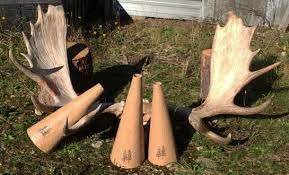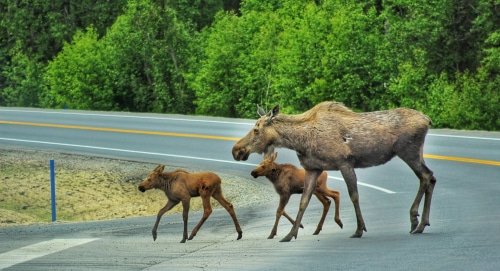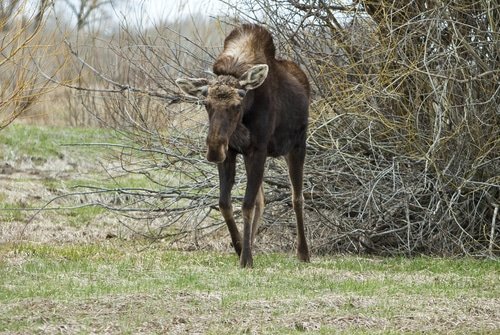When it comes to hunting these magnificent creatures, the importance of moose call cannot be overstated. A well-executed moose call for hunting can be the difference between a successful hunt and a disappointing day in the wilderness.
By imitating the vocalizations of moose, hunters can attract them closer and increase their chances of a sighting or even bagging a trophy bull. The art of moose calling allows hunters to tap into the natural instincts and curiosity of these majestic animals. This creates an opportunity for interaction that would otherwise be elusive.
Overview of Moose Behavior and Communication
Understanding moose behavior and communication is vital for any hunter who seeks success in luring moose within range. These magnificent creatures have their own unique ways of interacting with each other through various vocalizations.
From the deep grunts and roars of dominant bulls to the soft cow calls that signify reproductive readiness, moose communicate with one another using an intricate language that hunters can leverage to their advantage. Moose behavior is influenced by factors such as mating season (known as “the rut”), food availability, territoriality, and weather conditions.
By studying these behaviors, hunters gain insights into when and how to use specific calls effectively throughout different stages of the hunting season. With patience, skill, and knowledge about moose communication patterns, hunters can maximize their chances of a successful encounter in the wild.
Remember: mastering effective moose calling techniques requires practice and experience. So get ready to dive into this immersive world where your voice becomes a tool for luring majestic creatures closer than ever before!

Understanding Moose Communication
Different types of moose vocalizations
Moose, those majestic creatures of the wild, have a unique way of communicating with each other. They possess a repertoire of vocalizations that helps them convey messages to their fellow moose. These vocalizations can be broadly classified into three main types: cow calls, bull grunts and roars, and calf distress calls.
Cow calls: The Symphony of the Forest.
When it comes to luring moose, cow calls are indispensable. The melodious tunes produced by female moose serve to attract interested bulls during the rut season or to maintain contact with their offspring.
Cow calls range from low-pitched mews and mew with trailing wails to soft grunts and hyper-nasal whines. By mastering these authentic cow sounds through effective moose-calling techniques, hunters can increase their chances of attracting a curious bull ready for an encounter.
Bull grunts and roars: The resonant voice of dominance
Bull moose are known for their impressive displays of strength and authority during mating season battles. They emit deep grunts and roaring sounds that reverberate through the forest to establish dominance or intimidate rivals.
These guttural expressions are used both as an aggressive warning signal and a means to assert superiority in front of competing males. For hunters seeking trophy bulls, mimicking these authoritative tones can effectively engage dominant targets.
Calf distress calls: The plaintive cries of vulnerability.
Calf distress calls are heart-wrenching pleas emitted by young moose when they feel threatened or separated from their mothers. These high-pitched wails aim to attract attention and assistance from nearby adult moose in times of danger or confusion. In hunting scenarios where attracting protective cows is desired, incorporating calf distress calls into moose-calling techniques can effectively elicit a response and draw in a curious or concerned female.
Choosing the Right Moose Call
Types of moose calls available in the market
When it comes to selecting the perfect moose call, hunters have several options to choose from. The market offers a range of specialized calls designed to mimic different moose vocalizations. Understanding the types of moose calls available can greatly enhance your chances of luring in these majestic creatures.
External reed calls
One popular option is the external reed call. These are typically wood or plastic and consist of a hollow tube with an adjustable reed on one end.
You can produce different cow or bull sounds by manipulating airflow through the reed. External reed calls are versatile and relatively easy to use, making them a great choice for beginners.
Diaphragm mouth calls
Another type worth considering is the diaphragm mouth call. These calls fit inside your mouth like a traditional whistle or harmonica. These compact and lightweight devices are made from latex or rubber, allowing hands-free operation while delivering realistic sounds. Diaphragm mouth calls require practice to master proper airflow control but offer greater control over pitch and volume.
Electronic callers
Electronic callers have gained popularity in recent years for those looking for advanced technology. These devices come loaded with pre-recorded moose sounds that can be played at the push of a button.
Electronic callers provide unmatched convenience and can replicate various vocalizations with remarkable accuracy. However, it’s important to check local hunting regulations as some areas may restrict their use.
When choosing a moose call, consider factors such as ease of use, portability, durability, and realistic sound production. Experimenting with different types will help you find one that best suits your style and preferences—enhancing your ability to master effective moose-calling techniques while out in the wild.
Mastering the Art of Moose Calling Techniques
The Allure of the Cow-in-Estrus Call: Timing and Rhythm
Regarding effective moose calling techniques, a cow-in-estrus call is a powerful tool in your hunting arsenal. This mimics the vocalizations of a female moose in heat and grabs the attention of those love-struck bull moose.
However, timing and rhythm are crucial to convincingly executing this call like a delicate dance. Begin with a short series of calls, imitating the cadence and tempo of an aroused cow.
After each sequence, leave an appropriate pause to create anticipation for any potential suitors lurking nearby. Remember, patience is key when luring these magnificent creatures.
Pitch and Volume Control: The Melodic Melodies of Seduction
Moose are known for their keen sense of hearing, so mastering pitch and volume control is essential for creating a compelling illusion through your calls. While imitating cow vocalizations accurately is important, pay particular attention to adjusting your pitch according to prevailing environmental factors such as foliage density or wind conditions. Experiment with variations in volume, using softer tones when trying to entice cautious bulls or escalating intensity when aiming to attract those more distant suitors.
Bull Grunt Call: Unleashing Deep Resonance
Consider incorporating the bull grunt call into your hunting strategy to add another weapon to your repertoire of calling techniques. This evocative sound mimics dominant male moose during the rutting season by producing deep, resonant tones throughout their forest domain. By perfecting this technique, you can create a captivating experience that entices curious bulls into investigating your position.
Incorporating Pauses and Variations: The Element of Surprise
Moose communication is rich with nuance, and incorporating pauses and variations in your calls can greatly enhance their effectiveness. By intermittently stopping your calls, you create a sense of realism that mimics the sporadic vocal patterns of moose in the wild. Additionally, varying the intensity and rhythm of your calls can provoke curiosity and intrigue among potential suitors.
This element of surprise can prove invaluable when luring moose closer to your hunting location, increasing your chances of success. Mastering the art of moose-calling techniques requires practice, patience, and an understanding of these basic techniques.
By mastering the cow-in-estrus call with its impeccable timing and rhythm, controlling pitch and volume to captivate moose’s attention, utilizing deep, resonant tones in bull grunt calls, and incorporating pauses and variations for added authenticity, you will be well on your way to becoming a proficient moose caller. Remember that every call should be laden with purposeful intent as you immerse yourself in this ancient dance between predator and prey.
Advanced Moose Calling Strategies
Mocking aggressive bull sounds to attract dominant bulls
When luring in those big, dominant bulls, sometimes you must think outside the box. One effective technique is to mock their aggressive bull sounds. To do this, you must practice your grunts and roars until they sound like the real deal.
Start with a deep, resonant grunt, mimicking the low growl of a confident bull. Then, it slowly transitions into a powerful roar that sends vibrations through the forest.
This combination of vocalizations can catch the attention of nearby bulls and provoke their competitive nature. Authenticity is key here – you want to convince them that another alpha male is encroaching on their territory.
Utilizing cow-calf distress calls to lure protective cows or curious bulls
Protective cows and curious bulls can be enticed using cow-calf distress calls. These calls mimic the high-pitched vocalizations of a distressed calf separated from its mother.
By emitting these emotional pleas for aid, you appeal directly to their nurturing instincts or spark curiosity within them. The key is to convey vulnerability and urgency through your calling technique.
Start with a short series of high-pitched mews that indicate helplessness and gradually build intensity as if the calf is growing more desperate for its mother’s presence or protection. This technique can attract concerned cows looking for their calves and inquisitive bulls who want to investigate potential rivals in their territory.
Incorporating these advanced moose-calling strategies into your hunting repertoire can significantly increase your chances of success in luring moose closer for an opportunity at a well-aimed shot. However, always remember that mastering these techniques requires dedicated practice and careful observation of moose behavior during different seasons and rut phases.
Tips for Effective Moose Calling in Hunting Situations
Reading moose behavior through their responses to calls
When engaging in the art of moose calling during a hunting expedition, it is crucial to understand and interpret the responses of these majestic creatures. By keenly observing their reactions, hunters can gain valuable insights into their proximity and disposition.
Positive responses from moose may include approaching sounds or the distinct crackling of twigs underfoot as they move closer. These indications suggest that your calls are having an impact, luring the moose toward your position.
However, it is equally important to recognize negative responses such as sudden silence or rapid fleeing. Such behavior could signal caution or alertness, indicating that the moose has sensed danger or suspicion surrounding your calls.
Identifying positive responses (e.g., approaching sounds, breaking twigs)
Positive responses from moose while using effective moose-calling techniques can be quite exhilarating for hunters. When you hear the sound of approaching footsteps accompanied by faint rustling in the underbrush, it strongly indicates that your calls have piqued their curiosity.
The rhythmic crunching of twigs further confirms their gradual approach as they cautiously navigate closer to investigate the source of these enticing vocalizations. This positive response suggests that you’ve captured their attention and created a sense of intrigue, compelling them to explore further.
Recognizing negative responses (e.g., silence, fleeing)
Silence can be deafening when engaging in moose calling during hunting expeditions. If there is an abrupt cessation of any sound after you’ve executed a call sequence, it could indicate two scenarios: either your calls failed to resonate with the moose appropriately, or they have detected something suspicious about your presence and decided against investigating further.
In some cases, you might witness the moose suddenly bolting away rather than silence, displaying their incredible agility and speed. This negative response suggests that your calls may have raised alarms or failed to convince them of your authenticity.
Recognizing these signals is crucial to adjusting your approach by altering the intensity and frequency of your calls or strategically repositioning yourself to regain their attention and trust. The next section will discuss common mistakes hunters should avoid when using moose calls to ensure a successful hunting experience.
Common Mistakes to Avoid When Using Moose Calls
Overcalling: Knowing when to stop calling
When it comes to moose calling, one of the most common mistakes hunters make is overcalling. They get so caught up in the excitement of luring moose closer that they forget that less is often more.
Continuous and excessive calling can have the opposite effect, scaring away the animals you are trying to attract. It’s important to remember that moose are naturally cautious creatures, and constant noise can make them suspicious or even spook them.
Instead, employ a more strategic approach by intermittently using effective moose-calling techniques and giving the moose time to respond. Allowing for periods of silence between calls creates a sense of realism and increases your chances of drawing in a curious or territorial bull.
Incorrect timing: Adapting calling strategies
Timing plays a crucial role in successful moose hunting with calls. Many hunters make the mistake of assuming that their chosen calling techniques will work effectively throughout the entire hunting season. However, different seasons bring different behaviors from moose due to rut phases and other factors.
Understanding these variations can greatly enhance your chances of success. During early season hunts, when bulls are less aggressive, focusing on cow calls rather than aggressive bull grunts is advisable.
This mimics the natural behavior when bulls still assess their competition before engaging in full-blown battles for dominance. As the rut progresses into its peak phase, bull grunts become more effective as they correspond with increased testosterone levels and heightened aggression among mature males vying for mating opportunities.
At this stage, incorporating aggressive roaring sounds can attract dominant bulls looking for potential challengers. Towards late-season hunts, as mating activity wanes, cows become more responsive to calf distress calls since they become more protective of their young offspring.
By adapting your calling techniques to match the specific rut phases, you increase your chances of luring in moose most receptive to the sounds you produce. By avoiding the common mistakes of overcalling and incorrect timing, you can significantly improve your success rate when using moose calls for hunting.
Remember to observe moderation in your calling frequency and adapt your strategies based on the specific season and rut phases. These subtle adjustments can make a big difference in effectively communicating with these majestic creatures.
Utilizing Decoys and Scents
When it comes to luring moose, decoys can be an invaluable tool. Setting up a realistic moose decoy near your calling position creates an enticing visual stimulus that can attract curious bulls or protective cows. Ensure the decoy is placed in a natural-looking position, such as feeding or bedded down, to make it more convincing.
Additionally, incorporating moose scents into your hunting strategy can further enhance your chances of success. Applying cow urine or estrus scent to trees or vegetation near your calling area can create a realistic olfactory lure that draws interested moose.
Employing Stealth and Concealment
Moose have exceptional senses, particularly their acute hearing and sense of smell. To increase the effectiveness of your moose calling techniques, it’s crucial to remain stealthy and concealed during the hunt.
Moving slowly and deliberately while avoiding making unnecessary noise will help ensure you don’t spook any nearby moose before they can respond to your calls. It’s also advisable to wear camouflage clothing that matches the surroundings and use natural covers such as bushes or trees to break up your silhouette.
Patience and Persistence
Successful moose hunting requires patience and persistence in abundance. Remember that not every attempt will yield immediate results, even with the most effective calling techniques and tools.
Moose may take time to respond or approach cautiously before committing fully. It’s crucial not to give up too quickly; maintaining focus and staying dedicated are key qualities for any hunter seeking success with moose calls.
Conclusion
Mastering the art of moose call for hunting involves understanding their communication patterns, choosing appropriate calls, employing effective techniques, and utilizing additional tools. By mimicking the sounds of cow calls or bull grunts with the right moose call and incorporating strategies like decoys, scents, stealth, and patience, hunters can significantly increase their chances of encountering these majestic creatures.
Remember, hunting is not solely about the harvest but also about embracing the natural world around us and appreciating these magnificent animals in their natural habitat. So venture forth with confidence and respect for nature, and may your moose-hunting endeavors be filled with excitement and rewarding experiences.





